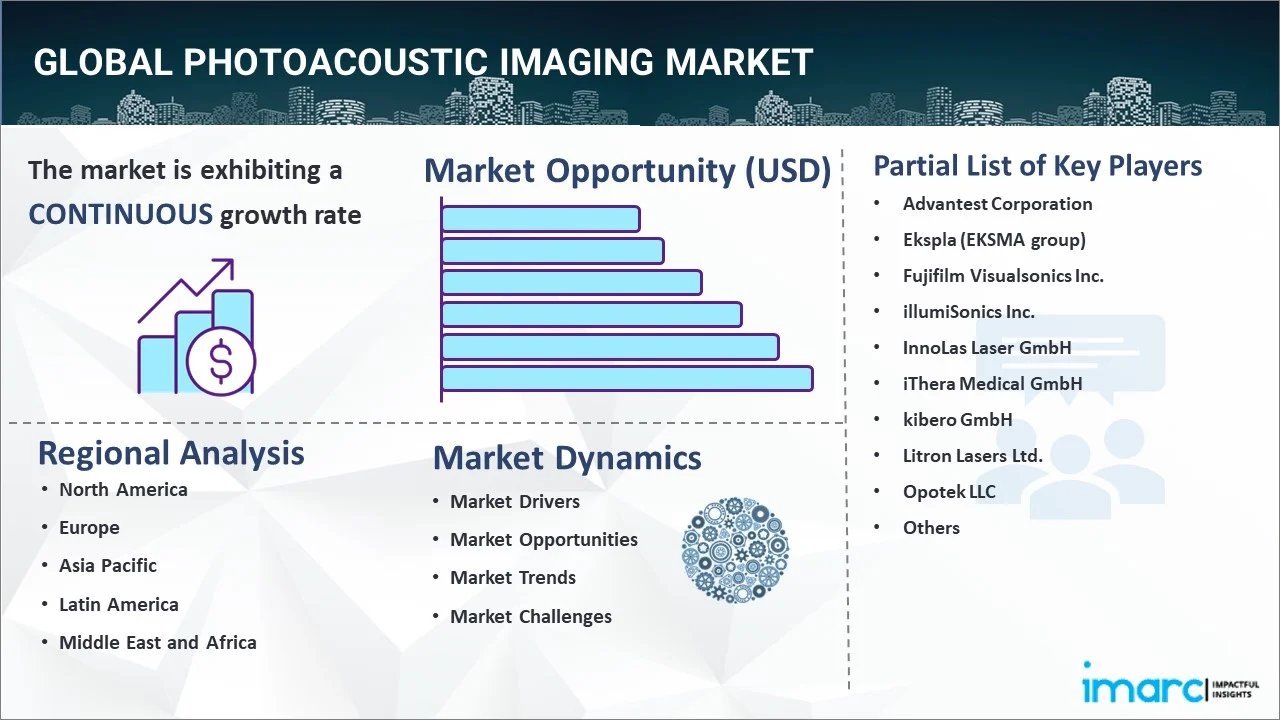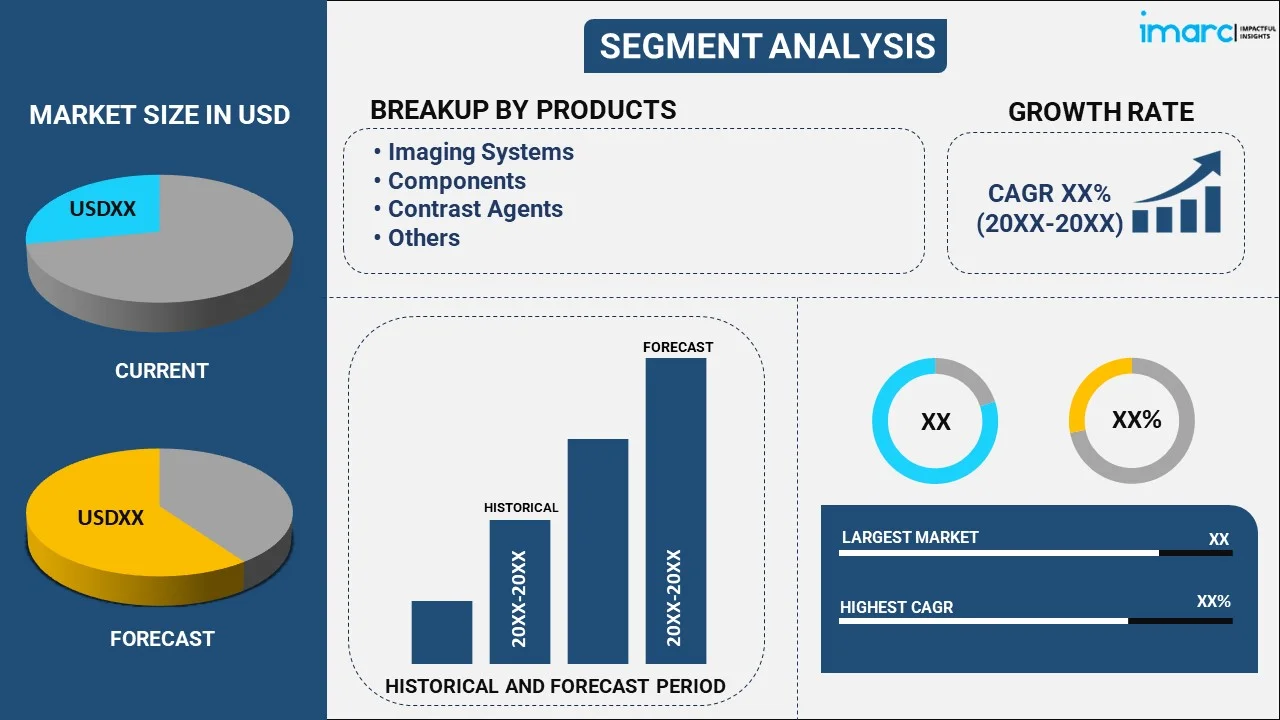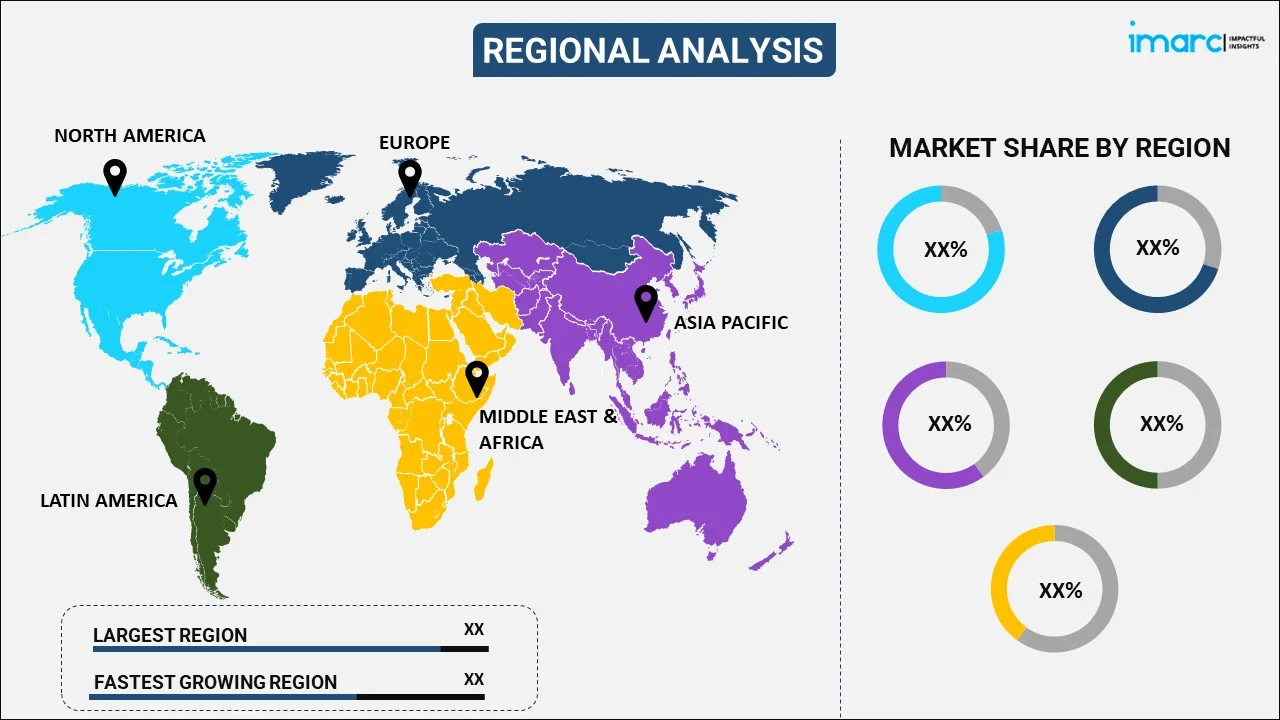
Photoacoustic Imaging Market Report by Product (Imaging Systems, Components, Contrast Agents, Software, and Others), Indication (Oncology, Cardiology, Neurology, Hematology, and Others), Application (Pre-Clinical, Clinical), End Use (Hospital and Clinics, Research Institution, and Others), and Region 2025-2033
Photoacoustic Imaging Market Size:
The global photoacoustic imaging market size reached USD 109 Million in 2024. Looking forward, IMARC Group expects the market to reach USD 317 Million by 2033, exhibiting a growth rate (CAGR) of 12.6% during 2025-2033. The market growth is primarily driven by the ongoing advancements in hybrid imaging technologies, the expanding use of photoacoustic imaging in oncology for high-resolution tumor visualization, and rising investments in research and development to improve diagnostic accuracy and explore new clinical applications.
|
Report Attribute
|
Key Statistics
|
|---|---|
|
Base Year
|
2024
|
|
Forecast Years
|
2025-2033
|
|
Historical Years
|
2019-2024
|
|
Market Size in 2024
|
USD 109 Million |
|
Market Forecast in 2033
|
USD 317 Million |
| Market Growth Rate 2025-2033 | 12.6% |
Photoacoustic imaging, also known as optoacoustic imaging, is a non-invasive biomedical imaging technique that captures images of biological tissues without using ionizing radiation. It is a hybrid modality that functions on the photoacoustic effect, wherein absorbed optical energy is converted into acoustic energy. It offers various advantages over conventional imaging techniques, including high penetration, depth, and image resolution, no harmful ionizing radiation, and molecular targeting at imaging depth. It is employed in detecting physiological properties and naturally occurring chromophores, such as lipids, melanin, hemoglobin concentration, and water and oxygen saturation. Besides this, it is extensively used for tumor mapping, functioning of the brain, detecting skin melanoma, and measuring methemoglobin. As a result, photoacoustic imaging is gaining immense traction across the globe.

Photoacoustic Imaging Market Trends:
Continual Technological Advancements in Imaging Systems
According to the photoacoustic imaging market, the demand is increasing significantly due to ongoing developments in imaging technology. More advanced hybrid imaging systems are offering improved functional imaging and higher resolution through the combination of photoacoustic imaging with optical and ultrasonic approaches. These developments render it possible to visualize biological tissues in real time with better depth penetration and contrast, especially for oncology and cardiovascular applications. Improved image reconstruction and interpretation through advanced software and algorithms are being preferred by the masses. A recent study introduced a non-contact photoacoustic method using a silicon photonics based LDV, which outperformed commercial systems and reconstructed accurate 2D images. These technological innovations are making the systems more versatile, driving their adoption in both research and clinical settings, and supporting the overall market growth.
Growing Application in Oncology
The increasing application of these imaging solutions in oncology is also contributing to the photoacoustic imaging market growth. Its ability to provide high-resolution images of tumor vasculature and tissue oxygenation levels renders the technique invaluable for early cancer detection, tracking treatment response, and guiding surgery. For patients who need repeated scans, non-invasive photoacoustic imaging is a safer option than conventional imaging modalities such as CT and MRI. More precise, real-time diagnostic instruments are becoming increasingly popular as the prevalence of cancer rises worldwide.
Increasing Research and Development Investments
The market is expanding more quickly as a result of the growing research and development (R&D) expenditures, thereby augmenting the photoacoustic imaging market share. In order to improve patient outcomes and diagnostic accuracy, businesses and research institutes are concentrating on developing imaging systems and investigating novel clinical applications. The rapid development of novel contrast agents enhancing the imaging of certain tissues and disorders is another goal of these efforts. In addition to the advancement of core technologies, ongoing innovation in this field is also being further supported by government financing and strategic collaborations between industry and academics. Consequently, research and development endeavors are broadening the possible uses of photoacoustic imaging, propelling demand in diverse medical and research domains, and augmenting photoacoustic imaging market analysis.
Photoacoustic Imaging Market Segmentation:
IMARC Group provides an analysis of the key trends in each sub-segment of the global photoacoustic imaging market research report, along with forecasts at the global, regional, and country level from 2025-2033. Our report has categorized the market based on product, indication, application, and end use.
Breakup by Product:

- Imaging Systems
- Components
- Lasers
- Transducers
- Contrast Agents
- Software
- Others
Breakup by Indication:
- Oncology
- Cardiology
- Neurology
- Hematology
- Others
Breakup by Application:
- Pre-Clinical
- Clinical
Breakup by End Use:
- Hospital and Clinics
- Research Institution
- Others
Breakup by Region:

- North America
- United States
- Canada
- Asia-Pacific
- China
- Japan
- India
- South Korea
- Australia
- Indonesia
- Others
- Europe
- Germany
- France
- United Kingdom
- Italy
- Spain
- Russia
- Others
- Latin America
- Brazil
- Mexico
- Others
- Middle East and Africa
Competitive Landscape:
The report has also provided a comprehensive analysis of the competitive landscape in the global photoacoustic imaging market. Detailed profiles of all major companies have also been provided. Some of the companies covered include:
- Advantest Corporation
- Ekspla (EKSMA group)
- Fujifilm Visualsonics Inc.
- illumiSonics Inc.
- InnoLas Laser GmbH
- iThera Medical GmbH
- kibero GmbH
- Litron Lasers Ltd.
- Opotek LLC
- Photosound Technologies Inc.
- Seno Medical Instruments
- Tomowave Laboratories Inc.
Kindly note that this only represents a partial list of companies, and the complete list has been provided in the report.
Photoacoustic Imaging Market News:
- September 30, 2024: Researchers at UCL have created a novel handheld 3D photoacoustic scanner that produces incredibly detailed images quickly, enabling earlier disease diagnosis. Using ultrasonic waves produced by a laser, the scanner can see minute variations in blood arteries as deep as 15 mm into human tissues. It can be used in clinical settings due to its great speed and precision, which may help with the diagnosis of arthritis, cardiovascular illness, and cancer.
- August 30, 2023: A notable breakthrough in small animal imaging for preclinical research has been made with the release of TomoWave's LOIS-3D Laser Optoacoustic Imaging System. It provides three-dimensional, high-resolution images with unparalleled sensitivity by using optoacoustic/photoacoustic imaging to combine light and sound, thereby collecting vital data such as oxygen saturation and blood content. This breakthrough enhances understanding of disease mechanisms, enabling more accurate research, and paving the way for next-generation therapies. TomoWave's upcoming ARIA system promises further improvements, combining optoacoustic tomography with real-time ultrasound.
Photoacoustic Imaging Market Report Scope:
| Report Features | Details |
|---|---|
| Base Year of the Analysis | 2024 |
| Historical Period | 2019-2024 |
| Forecast Period | 2025-2033 |
| Units | Million USD |
| Segment Coverage | Product, Indication, Application, End Use, Region |
| Region Covered | Asia Pacific, Europe, North America, Latin America, Middle East and Africa |
| Countries Covered | United States, Canada, Germany, France, United Kingdom, Italy, Spain, Russia, China, Japan, India, South Korea, Australia, Indonesia, Brazil, Mexico |
| Companies Covered | Advantest Corporation, Ekspla (EKSMA group), Fujifilm Visualsonics Inc., illumiSonics Inc., InnoLas Laser GmbH, iThera Medical GmbH, kibero GmbH, Litron Lasers Ltd., Opotek LLC, Photosound Technologies Inc., Seno Medical Instruments and Tomowave Laboratories Inc. |
| Customization Scope | 10% Free Customization |
| Post-Sale Analyst Support | 10-12 Weeks |
| Delivery Format | PDF and Excel through Email (We can also provide the editable version of the report in PPT/Word format on special request) |
Key Questions Answered in This Report:
- How has the global photoacoustic imaging market performed so far and how will it perform in the coming years ?
- What has been the impact of COVID-19 on the global photoacoustic imaging market ?
- What are the key regional markets ?
- What is the breakup of the market based on the product ?
- What is the breakup of the market based on the indication ?
- What is the breakup of the market based on the application ?
- What is the breakup of the market based on the end use ?
- What are the various stages in the value chain of the industry ?
- What are the key driving factors and challenges in the industry ?
- What is the structure of the global photoacoustic imaging market and who are the key players ?
- What is the degree of competition in the industry ?
Need more help?
- Speak to our experienced analysts for insights on the current market scenarios.
- Include additional segments and countries to customize the report as per your requirement.
- Gain an unparalleled competitive advantage in your domain by understanding how to utilize the report and positively impacting your operations and revenue.
- For further assistance, please connect with our analysts.
 Inquire Before Buying
Inquire Before Buying
 Speak to an Analyst
Speak to an Analyst
 Request Brochure
Request Brochure
 Request Customization
Request Customization




.webp)




.webp)












